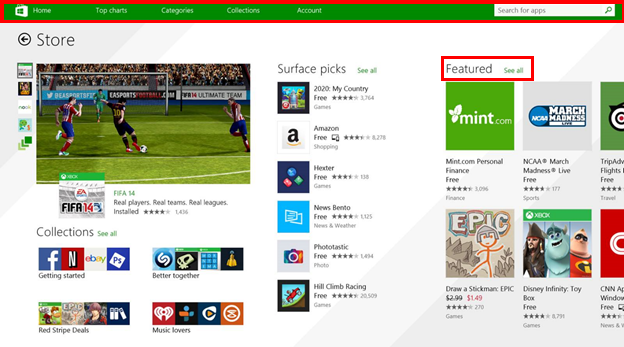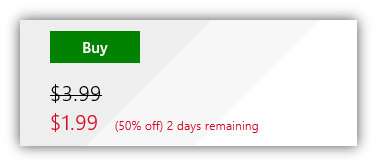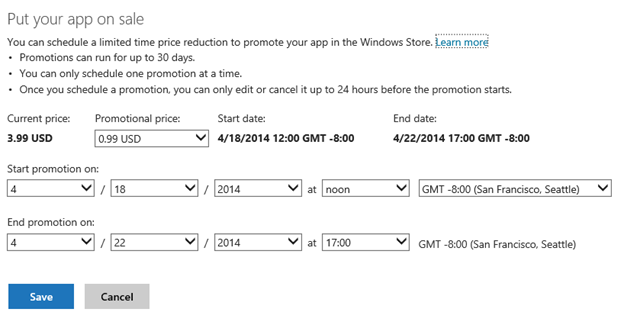Providing a great shopping experience keeps users coming back to the Store. We’re constantly working to improve the way apps are presented, to help users search for specific app titles. Today I’d like to talk about a few enhancements we’re rolling out to make the Windows Store experience even better, and what that means for developers.
Last month’s Windows 8.1 Update made it easier for users to find and stay connected to their favorite apps by placing the Store icon in the taskbar and enabling apps to be pinned to the taskbar for desktop users.
Today, we begin rolling out an update that will provide an enhanced user experience inside the Windows Store itself. We’ve also enabled developers to do price promotions on their apps, and amended Windows Store policies for phone, tablet and PC apps to further improve app discoverability and minimize customer confusion.
Enhanced Windows Store user experience
Today’s update focuses on enhancements that address customer feedback and makes it easier for users to find your apps including:
- Persistent Store navigation bar – enables users to discover and filter apps by Category, Top charts and Collections
- Collections – expanded set of Collections, accessible from the Store landing page. Some collections will also show the ability to “Install All” the apps in that collection, which will make it easier for consumers to start using apps in collections
- Featured apps and new ‘top’ lists – new sections help promote great new apps. The ‘Top grossing’ list includes apps that generate revenue through download to own or in-app purchase
- Increased app density – throughout the refresh you’ll notice an increase in the volume of apps promoted
For more information and details about the new Windows Store refresh see today’s post on the Experience Windows blog.
Universal indicator
|
|
Starting with today’s update, Windows Store users will see the universal indicator identifying apps available for both Windows and Windows Phone that have been linked in Dev Center, and can be purchased once for use on compatible Windows 8.x and Windows Phone 8.1 devices. The ability to purchase once is coming to Windows Phone 7 and 8 later in the year. Learn more about the indicator and linking apps. |
Price promotions on Windows Store
App discounts and sales are a proven method of promoting an app, driving acquisitions and gaining new customers.
Starting today, Windows Store developers can put their paid apps on “sale” in the Windows Store by choosing a new, lower price tier (including free), the start date/time, and end date/time. When the app promotion begins, customers will see the old price with a strikethrough, the new price and the discount as a percentage. The Store also tells the customer when the sale ends which drives conversions by underscoring the limited time aspect of the promotion.
Developers do not need to submit a new release to change the price of their app, rather they simply schedule a price promotion using the Dev Center UI (shown below), which appears on the App Details page. The promotion price automatically reverts to the original price when sale ends.
Windows Store Certification Requirements updates
Another way that we’re increasing Store engagement is by taking steps to help users find and install the apps they’re looking for without sorting through confusing lists of similar titles. We think it’s reasonable for users to expect apps to offer distinct value and feature names that accurately represent the app’s capability. With the latest release (6.0) of the App certification requirements for the Windows Store, we made changes to streamline the requirements. We’ve also adopted policies to ensure that apps are described and named in a way that doesn’t misrepresent the app purpose.
Category Guidance
Users generally expect an app to be categorized according to the app function and purpose. For example, if the app is a guide for gameplay, it should be clear to the user prior to purchase that it is a guide and not a game. This policy update will help ensure that an app like this is not categorized under games, but is instead placed in a more appropriate category such as books and reference.
App Naming Guidance
Similarly an app title needs to clearly and accurately reflect the functionality of the app so customers know what they’re downloading. If your app is a game guide, is should highlight that as a primary function in the title. Revised policies will help guard against app names that too closely resemble an app that is already available.
Examples:
|
Acceptable |
Not Acceptable |
|
Game Guide for <Game> |
<Game Name> Game Guide |
|
<Functionality or Descriptor> for <Original App Name> |
<Original App Name> <Functionality or Descriptor> e.g. Microsoft Office Features |
Icon Guidance
Your app icons also need to be differentiated from icons for other apps and needs to prominently feature imagery and text that will not be mistaken with others. If using text in the icon, follow the App Naming Guidance outlined above.
|
Original app |
Acceptable icon for related app |
Not acceptable |
 |
 |
  |
Next steps
I recommend a few actions to help you get started:
1) Download the latest Windows update to start using the refreshed Store. You’ll want to review your Windows app metadata (particularly app names and iconography) to minimize certification or policy failures. If you are contacted with a request to make updates, make sure to resubmit your app as soon as you can, you’ll want your app to be visible in the new Windows Store user experience.
2) Consider linking your existing Windows Store and Windows Phone Store apps to increase discoverability and download across platforms.
3) If you missed the news earlier this week, Visual Studio 2013 Update 2 reached RTM and is now available for download, as are the recently released Microsoft Ad SDKs that include rich media units to help increase your eCPM.
4) Finally we also recently posted new JumpStart content to help you get started building universal Windows apps.
Be sure to let me know your questions and feedback as you check out the Store refresh and download the final tools.





